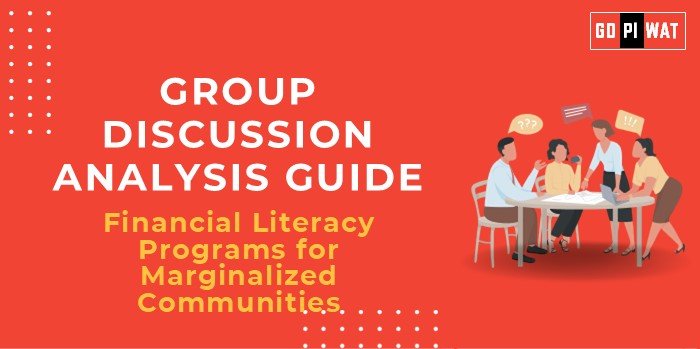📋 GD Analysis Guide
💡 How Can Financial Literacy Programs Be Made More Accessible to Marginalized Communities?
🌟 Introduction to the Topic
Opening Context: “Financial literacy is a critical driver of economic empowerment, particularly for marginalized communities who often lack the knowledge and access necessary for financial independence and security.”
Topic Background: Financial literacy programs aim to empower individuals by teaching essential skills in budgeting, saving, credit management, and financial planning. For marginalized groups, enhancing accessibility can bridge socio-economic gaps and lead to greater inclusion in mainstream financial systems.
📊 Quick Facts and Key Statistics
- 🌍 Global Financial Literacy Rate: Only 33% of adults worldwide are financially literate, highlighting the urgency for targeted interventions (S&P Global FinLit Survey).
- 🇮🇳 India’s Financial Inclusion Growth: Over 460 million bank accounts opened under the Pradhan Mantri Jan Dhan Yojana (PMJDY) since 2014. However, financial literacy among account holders remains low.
- 📱 Digital Financial Services Usage: Significant growth in digital transactions in rural India, but challenges like limited digital literacy and inadequate infrastructure persist.
- 👩 Gender Financial Literacy Gap: Women globally lag behind men in financial literacy, with a persistent 5% gap (OECD, 2023).
- 💵 Economic Behavior Impact: Marginalized households with basic financial literacy increased savings by 20% and reduced borrowing costs by 10% (World Bank, 2022).
🔍 Stakeholders and Their Roles
- 🏛️ Government Agencies: Design policies and implement accessible financial education infrastructure (e.g., financial literacy camps).
- 🌿 NGOs and Civil Societies: Conduct on-ground campaigns tailored for diverse communities.
- 🏦 Banks and Financial Institutions: Provide resources, training sessions, and products targeting financial inclusion.
- 📱 Tech Companies: Develop user-friendly financial apps and platforms for underprivileged groups.
- 👥 Community Leaders: Act as trusted advocates for financial literacy within their communities.
🏆 Achievements and Challenges
Achievements:
- 💳 Pradhan Mantri Jan Dhan Yojana (PMJDY): Over 400 million bank accounts opened since 2014, boosting financial access.
- 👩🔧 Self-Help Groups (SHGs): Enhanced savings habits and financial skills in women-led rural enterprises.
- 📈 Digital Literacy Programs: Increased mobile-based transactions through targeted digital literacy initiatives.
Challenges:
- 🚧 Access Barriers: Limited physical access to banks and digital tools in remote areas.
- 👩🎤 Cultural Constraints: Social norms often hinder women’s participation in financial education.
- 📚 Education and Awareness Gaps: Low financial literacy rates persist, particularly in rural populations.
- 🌍 Global Comparisons: Kenya’s M-Pesa serves as a benchmark for integrating mobile money solutions with financial literacy.
📄 Structured Arguments for Discussion
- ✅ Supporting Stance: “Making financial literacy more accessible to marginalized communities strengthens economic resilience, reduces poverty, and promotes financial independence.”
- ❌ Opposing Stance: “Despite efforts, many programs remain ineffective due to a lack of localized and context-sensitive content, creating barriers to true financial empowerment.”
- ⚖️ Balanced Perspective: “While financial literacy initiatives have shown progress, addressing local challenges like infrastructure gaps and gender disparities remains key to achieving meaningful inclusivity.”
✨ Effective Discussion Approaches
- 📜 Opening Approaches:
- “According to global surveys, less than one-third of adults worldwide are financially literate. This stark reality demands targeted and inclusive financial literacy programs.”
- “India’s Pradhan Mantri Jan Dhan Yojana created a significant boost in financial inclusion, but financial literacy lags behind, posing a major challenge.”
- 💬 Counter-Argument Handling:
- “Addressing criticisms around program effectiveness starts by ensuring community-specific content, practical training, and leveraging local leaders.”
🔍 Strategic Analysis of Strengths and Weaknesses
- 💪 Strengths: Enhanced access to banking, mobile-based solutions, and governmental focus on inclusion.
- ⚠️ Weaknesses: Literacy gaps, cultural barriers, and limited program reach in remote areas.
- 🌱 Opportunities: Expansion of digital literacy programs and public-private partnerships.
- 🚨 Threats: Resistance to change, cybersecurity concerns, and lack of sustained engagement.
📚 Connecting with B-School Applications
- 💼 Real-World Applications: Link financial inclusion to themes like microfinance, sustainable economic development, and digital transformation in finance.
- 🎓 Sample Interview Questions:
- “How can technology further financial inclusion for marginalized groups?”
- “Evaluate the role of public-private partnerships in enhancing financial literacy.”
- 💡 Insights for B-School Students: Recognize the importance of targeted interventions, potential for microfinance innovations, and the role of leadership in community change.


